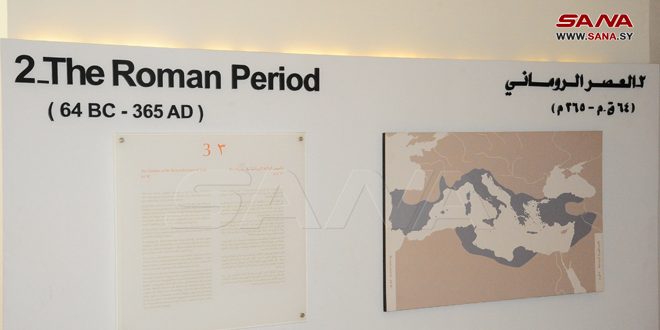Classic section of the National Museum in Damascus includes collection of antiquities dating back to Roman period 64 BC
The classical section of the National Museum in Damascus includes an important collection of artifacts dating back to the Roman period 64 BC / 365 AD.
This period begins, according to the curator of the Classical Museum, Ali al-Habib, with the victory of the Roman commander Pompey over the army of Antiochus thirteenth Seleucid in 64 BC. What marked the end of the Seleucid Empire and the beginning of the Roman state in Syria and its capital, Antioch, where the Romans’ control over the regions gradually extended thanks to the construction of a network of forked roads It connects the east with the west and the north with the south.
Trade was the most important economic resource in Syria during the Roman period because of its distinguished location and formed a hub for the movement of precious goods “silk-spices-perfumes” from East Asia to the western parts of the Roman Empire.
Al-Habib vlarified that Antioch became the third most important city in the Roman world after Rome and Alexandria, and Hellenistic cities such as Damascus, Aleppo, Apamea, Latakia and Bosra took on new manifestations that reflect the typical Roman lifestyle, such as the market, theaters, baths, and paved streets.
He pointed out that the Roman period included a variety of artifacts arranged in the National Museum in Damascus as follows daily life, which includes a set of saddles and adornment tools “hair clips – bracelets – mirrors – collars – amulets and pendants” as well as a group of pottery “plates – jugs – covers” Pottery incense burners dating back to the first-third century AD.
The group of local products and trade includes pottery vessels that were used to transport and store liquids. We also find a set of Roman coins bearing images of a group of Roman emperors dating back to the first-third century AD.
As for the set of medical tools and equipment, Al-Habib said that some of them are used for inspection and some of them are used to prepare or preserve medicine. We also find a carving of two figures of limestone standing naked, one of whom draws poison from the hand of the other. It was dated to the first-third century AD.
A group of stone statues representing the art of writing at the time and glassware – kohl – plates – jugs – bowls – cups – flasks dated to the first – third century AD, in addition to the statue of Doryphorius the javelin and a number of mosaic panels depicting several legends such as a painting glorifying the earth and a painting The three goddesses.
As for the sculpture, the National Museum in Damascus has a collection of various stone carvings, such as the marble ark of Rastan, discovered in 1977 AD, on which scenes from the Trojan War were represented in a relief and beautiful manner.
Regarding the area of cities and regions, Al-Habib explained that it has a group of distinctive sculptures and artifacts from Apamea, Homs, Latakia, Hauran, Golan and Dora Europos, which includes a group of carvings of gods and people made of limestone and basalt stone as a sculpture by Sisha and Shadrafa, the Palmyra god of medicine, and the shepherd god Nimes, goddess of justice and revenge and Helios The sun The city of Dura-Europos was distinguished by its frescoes, one of which represents a wedding from Dura-Europos, as well as its distinctive synagogue.
Yerhai Palmyra cemetery is considered a model of Palmyra earthen funerary buildings. It was discovered in 1935 AD in a place called Wadi al-Qubur, which is the main cemetery in Palmyra. The cemetery was dismantled and rebuilt at a later time in the museum. For two centuries.
Concerning Palmyra Hall, Al-Habib spoke: “Palmyra is considered one of the greatest cities in the ancient world. It was an oasis halfway between the Mediterranean and the agricultural areas surrounding the Euphrates River. It played an important role in the trade exchange between East and West. And her queen Zenobia was of special importance during the Roman era, which guaranteed them immortality.”
He continued, “A lot of Palmyrene art is based on Roman, Hellenistic and Sasanian styles, but it was distinguished by the Palmyrene art’s focus on facial photography and showing the shapes of faces in a single style based on eternal expressions, where we do not find a trace of realism, and clothes and decorations appeared in a high-precision style, but this local style is under the pressure of influence.” The Roman turned to a more realistic style, especially in funerary statues, which includes a wonderful variety of Palmyrene carvings and tombstones, as well as a number of sculptures of gods and women, and a group of invitation cards, seals and textiles.
Basma Qaddour

